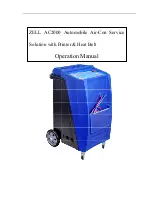
Setting Up the ELx800
|
19
Setting Up the ELx800
Operating Environment
The ELx800 is designed to operate optimally when installed on a level surface
in an area where ambient temperatures remain between 18
°
C (64.4
°
F) and 40
°
C
(104
°
F). The reader is sensitive to extreme environmental conditions, and these
conditions should be avoided:
•
Excessive humidity:
Condensation directly on the sensitive electronic
circuitry can cause the instrument to fail internal self-checks.
•
Excessive ambient light:
Bright sunlight or strong incandescent light
can reduce the linear performance range of the instrument.
•
Dust:
Optical density readings may be affected by extraneous particles
(such as dust) in the microplate wells. A clean work area is necessary to
ensure accurate readings.
Electrical Connections
Caution! Power Supply.
Only use the specified power
supply to ensure proper operation of the unit. The ELx800 has
a universal 24-VDC, 2-Amp power supply that functions from
100 to 240 V~ (± 10.0%) @ 50 to 60 Hz without external
switching.
Never use a two-prong plug adapter to connect primary
power to the ELx800 power supply. Use of a two-prong
adapter disconnects the utility ground, creating a severe
shock hazard. Always connect the supply power cord directly
to a three-prong receptacle with a functional ground.
1.
Connect the power cord to the external power supply.
2.
Plug the rounded end of the power supply line cord into the power
supply jack on the rear of the instrument.
3.
Tighten the knurled nut on the power supply outlet to ensure that
the plug does not pull out.
4.
Plug the 3-prong end of the power cord into an appropriate power
receptacle.
Warning! Power Rating.
T
he ELx800 power supply must
be connected to a power receptacle that provides voltage and
current within the specified rating for the system. Use of an
incompatible power receptacle may produce electrical shock
and fire hazards.
ELx800 Operator’s Manual
Summary of Contents for ELx800
Page 1: ...ELx800 Absorbance Microplate Reader Operator s Manual...
Page 2: ......
Page 4: ......
Page 40: ...12 Chapter 1 Introduction Bio Tek Instruments Inc...
Page 66: ...38 Chapter 2 Installation Bio Tek Instruments Inc...
Page 130: ...102 Chapter 3 Operation Bio Tek Instruments Inc...
Page 166: ...138 Chapter 5 Maintenance and Decontamination Bio Tek Instruments Inc...
Page 190: ...162 Appendix B Using 384 Well Geometry Bio Tek Instruments Inc...
Page 193: ...165 Figure 32 Curve Fit Report ELx800 Operator s Manual...
Page 195: ...167 Figure 34 Column Report without samples ELx800 Operator s Manual...
Page 196: ...168 Appendix C Report Format Figure 35 Panel Report Bio Tek Instruments Inc...
Page 197: ...169 Figure 36 Assay Detail Report Sheet 1 of 2 ELx800 Operator s Manual...
Page 200: ...172 Appendix D Comparison of the ELx800 and the EL800 Bio Tek Instruments Inc 172...
Page 214: ...186 Appendix E Instructions for Programming a New Assay Bio Tek Instruments Inc...
















































